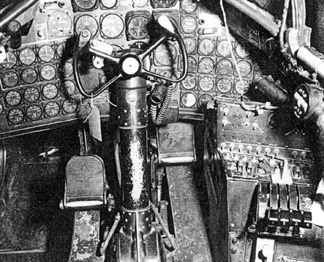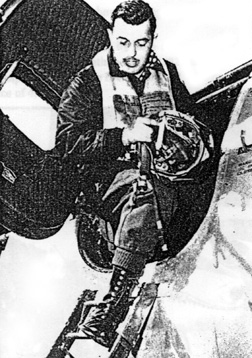Midnight Mission
|
|||||||||
|
Photos from the author’s collection and Warren M. Bodie Page 7 of 7 Pages
|
|||||||||
| The RB-45 was not equipped with TACAN or DME in those days. The most reliable piece of equipment for jet penetration was the old reliable low frequency radio compass (AN/ARN-6). This apparatus operated at a frequency range from 100 to 1750 kilocycles and was the mainstay for instrument letdowns. The greatest problem was that the frequency range of the equipment happened to coincide with the frequency band of thunderstorms, so that the directional needle was constantly drifting during penetrations where storm activity was present.
We could, of course, always use our Radar Navigator as a backup, with his APN-24 radar scope and ILS (Instrument Landing System), were available, and GCA (Ground Control Approach) was always a primary instrument source. When approaching Tokyo, a few miles from Yokota, the absolute best homing device was the commercial Tokoyo radio operating on what I can best remember as 1250 kilocycles. This we could pick up from almost 150 miles out. "Raven One, Komatsu Control here. Have you over our station, be advised, contact Yokota Approach frequency 236.8. Commence descent to flight level 2 five thousand, over." "Roger Komatsu, Raven here. Leaving your frequency for 236.8, starting descent to flight level 2 five thousand, over and out." "Yokota, Raven One here, over." "Roger Raven One. Yokota Approach. Be advised continue descent to flight level 2 zero zero. Give estimate time over Yokota Beacon, over." Yokota Raven here. Estimate from present position, 15 minutes to Yokota Beacon. Please give update on latest weather and runway conditions. Be advised we have one engine out and estimate only enough fuel for one pass, over." "Roger Raven One. Yokota here. Be advised weather at Yokota, ceiling 200 feet, visibility 1/4 mile with light snow, runway condition patchy ice, temperature 25 degrees, winds NW 15, altimeter 30.20 holding steady, GCA is standing by, ILS (Instrument Landing System) is inoperative. Continue to high cone, commence standard jet penetration upon arrival. Report on this frequency leaving 2 zero zero thousand feet, over." |
|||||||||
| We proceeded inbound with our cargo of exposed radar and visual film. The name of the game now was to deliver it to "Recce Tech" all in one neat package for evaluation and targeting information for the B-29s. Those crews of the 98th and 307th Bomb Wings at Yokota and Kadena Air Base on Okinawa were bedded down and fast asleep.
General Paul T. Cullen, the father of aerial reconnaissance for the RB-45 and other recon aircraft, would have been proud of the results of the reconnaissance effort in the Far East Theater of Operation during the Korean War. Unfortunately, he was killed in a C-124 crash in March of 1951, and never saw the fruits of his outstanding efforts on our behalf come to full realization. |
|||||||||
 |
|||||||||
|
Photo Ctsy. Howard Myers |
|||||||||
| "Yokota, Raven One here. Be advised, high cone this time commencing descent, minimum fuel, again one engine out. We don’t want to miss this pass; will have 200 pounds max fuel at touchdown, not enough for a go-around, over."
"Roger Raven One, maintain this frequency until turning final on your descent, then switch to Yokota GCA, frequency 245.6 for GCA approach to runway 35. Again, ceiling holding at 200 feet, visibility 1/4 mile with blowing snow. Tachikawa and Johnson are reporting same conditions (two bases within 15 miles of Yokota and often used as an emergency alternate for B-45 operations, but with much shorter runways.) Because the B-45 was such a clean aircraft, with no drag device, such as spoilers or air brakes to reduce speed during penetration, a conventional jet letdown ate up a great deal of mileage. To decrease altitude prior to penetration was too fuel inefficient. When the throttles were retarded and the nose lowered during a jet penetration from a nominal high cone altitude of 20,000 to 25,000 feet, the first thing to happen was a speed buildup. To prevent exceeding the maximum speed limitation of the aircraft, the rate of descent had to be kept within strict limitations. This, of course, increased the distance the aircraft traveled from the letdown beacon or radio range. Often this distance carried the B-45 a considerable distance from the airfield intended for landing. A spiraling descent could have been the answer, except traffic control more often than not made this impracticable. In later years with the B-47 and the B-52, it was simply a matter of lowering the landing gear and/or speed brakes to control rate of descent and reduce speed buildup. The answer in the B-45 was simply to optimize rate of descent vs. speed and distance to arrive at an acceptable pattern. Fuel consumed for the entire jet-type penetration and landing at Yokota was about 3000 pounds (roughly 500 gallons of JP-1 at 6 lbs. per gallon). Our fuel reading at the high cone (20,000 feet over the Yokota Radio Beacon) was about 3200 pounds, leaving us with an estimated 200 pound reserve at touchdown. Needless to say, making it on the first approach was essential. "Yokota GCA, Raven One here. Leveling off at 2000 feet, inbound 285 degrees, estimated 15 miles out. Do you have us for a straight-in for runway? Over." "Roger Raven One. Steer right 340, start descent to 1200 feet. Altimeter remains 30.20, winds gusting 310 degrees, 15 kts., visibility 1/4 mile. We have you 12 miles on final. Squawk Emergency IFF for 5 seconds, then return to Squawk 2-2 for remainder of run, hold this frequency... now have you 10 miles, start descent to 1000 feet ...steer right, heading 360 ...start descent 500 feet per minute." (Our fuel count was now down to 500 pounds.) "Raven One, increase rate of descent to 800 feet per minutes, you are drifting above the glide path ...distance 8 miles ...correct heading to 340, drifting right of centerline ...visibility 1/4 miles, runway lights intensity 6 ...back on glide slope, resume normal rate of descent." (A three-engine approach in the B-45, especially with an outboard engine out, required the pilot's utmost attention because of asymmetrical thrust.) "Raven One, have you on glide slope, on centerline, 6 miles from touchdown ..on glide slope, on centerline ...5 miles from touchdown ...coming back to glide slope ...on centerline ...ILS still inoperative ...back on glide slope ...resume normal rate of descent ...maintain heading 340 degrees. Slight crosswind from your left ...4 miles ...on glide slope, coming back to centerline ...correct heading to 342 ...on centerline, on glide path ...3 miles from touchdown." (Radar Navigator confirms by viewing his radar scope that we are 3 miles from runway.) "Raven One, you are on glide slope, on centerline ...should start to see runway lights any second reports GCA ...now drifting slightly above glide slope, increase descent ...on centerline ... 1 1/2 miles from end of runway." (At this point I still cannot see the runway lights. No strobes in those days!) "Raven One, confirm all checklist complete, gear fully down ...on glide slope, on center line 1 mile!" (At this point I can start to see the runway lights illuminating through the snow and darkened mass ahead of me ...there they are ...just ahead ...two rows of lights ...steady ...air speed 155 kts. ...start the round out ...100 feet ...50 feet ...on center ...15 feet ... touchdown ...ease the nose down ... engage nose gear steering.) In the B-45, steering was accomplished by engaging a toggle switch under the pilot’s left control column. Steering on the ground was then through the aileron controls; turn right, right aileron, turn left, left aileron. Ease on the brakes ...starting to skid ...lots of ice on the runway ...cut down #1 for better balanced thrust ...visibility very poor ...can't be over 100 feet. There's the 'follow me' jeep up ahead. "Yokota GCA, Raven here ...great run ...thanks for your help ...couldn't have made it without you!" "Roger Raven ...our pleasure ...all in a day's work ...QSY to Yokota Tower ...and good day, sir, over and out!" "Yokota Tower, Raven here, on the deck ...guns are clear (we fired the tail guns while over the Sea of Japan to expend all live ammunition before landing, as a safety precaution while on the ramp) ...be advised we will taxi to parking spot Zulu." We had made it around the circuit with 200 pounds of fuel to spare. Barely enough to taxi in. |
|||||||||
| The film was immediately unloaded, processed within an hour, sent to photo interpretation about the same time B-29 crews were being awakened at Yokota and Kadena for their strike for the day. By the time bomber crews had breakfast, the intelligence types had the most current and up-to-date information available, and the strike mission by the B-29s against the target we had just been over a few hours before was a complete success.
We had validated the correctness of the decision to paint the RB-45 black. Throughout the remainder of the Korean Conflict, no RB-45 was ever lost to enemy action as a result of the searchlight threat. |
|||||||||
 |
|||||||||
|
|
|||||||||
|
Page 1, Page 2, Page 3, Page 4, Page 5, Page 6, Page 7 To Go To — RB-45 Home — or — Miscellaneous RB-45 Home - Contact Us - Cold War Hist. - 91st SRS Hist. - Stardust 40 Mission Story |
|||||||||